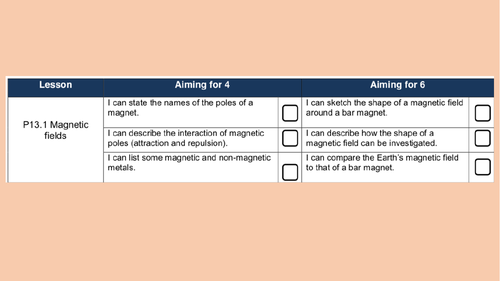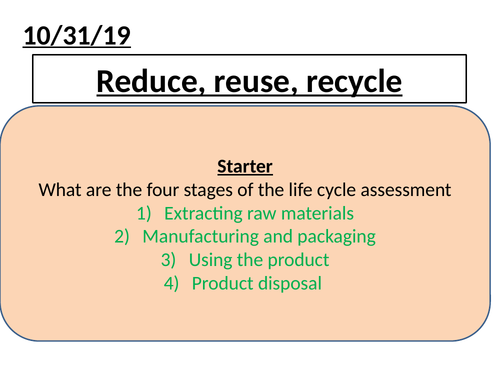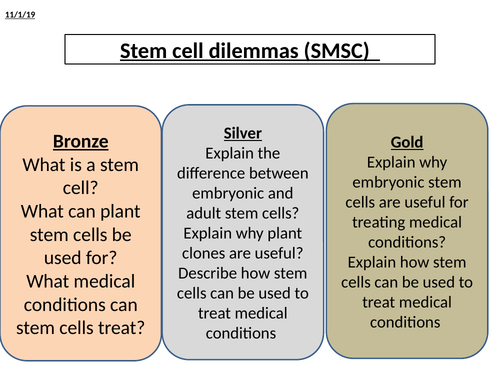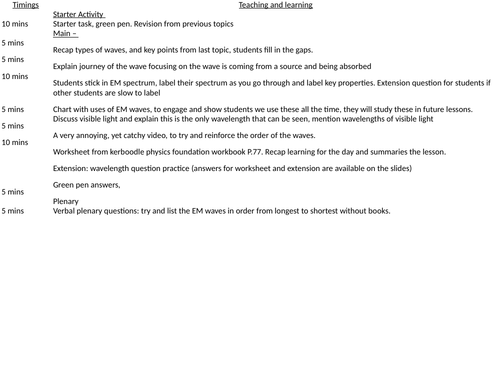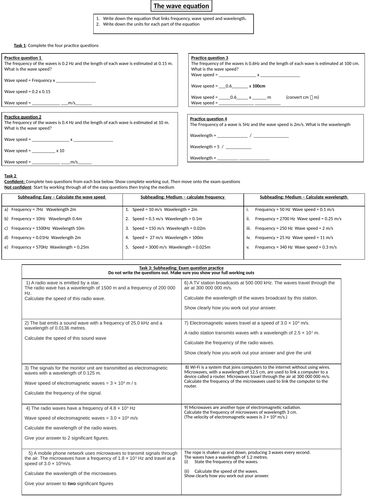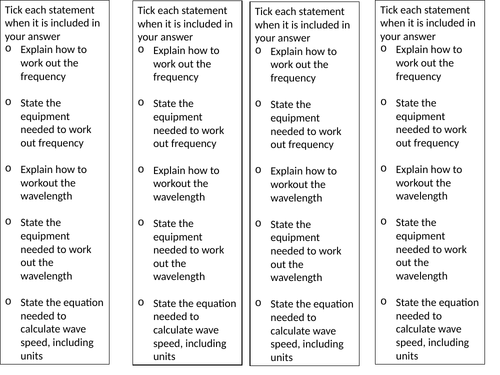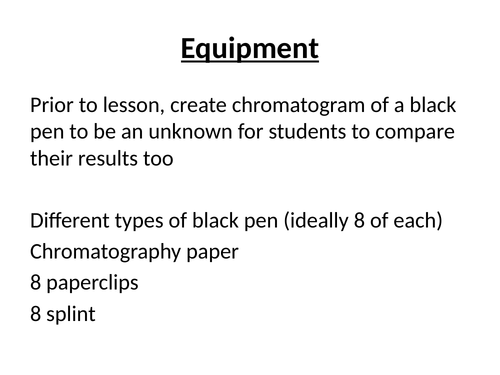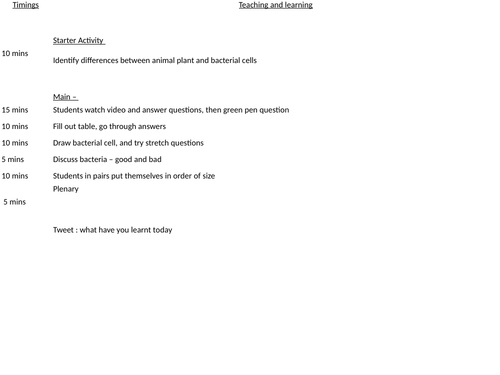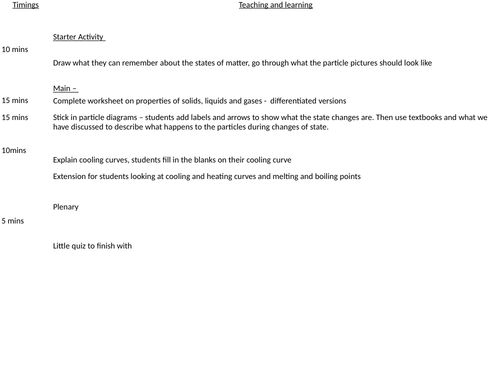
123Uploads
27k+Views
8k+Downloads
All resources

P13.1 Magnetic Fields
P13.1 accordin to AQA Kerboodle
Aimed at a low ability foundation class (targets level 4)
Stater: pictures to guess the title
Main: practical element to find out what poles of magnets do. Then to use iron fillins/compasses to show field lines. can be demoed
Work sheet to consolidate knowledge with an extension on induced/permanent magnets
Plenary: true/false questions based on content from the lesson

KS3 Respiratory system and gas exchange
Starter: Simple recall questions based on prior knowledge, easily changed to suit your class
Main:
Information about the respiratory system, then a labelling task, a putting in order task and questions to consolidate learning. All answers on the powerpoint.
Gas exchange information on the ppt also a drawing of how it can be taught under the visulisar, followed by questions to check understaning.
Plenary
True or false

C11.3 greenhouse gases
Aimed at foundation students, targets of level 4
Starter: differentiated bronze/silver/gold starter questions with answers
Main:
Draw the greenhouse effect using info from powerpoint. extension question to challenge students
Fact hunt: questions to answer using textbook
Video on deforestation, questions to answer from video
Plenary: animated true/false statements

C11.5 atmospheric pollutants
aimed at foundation level 4 targets
Differentiated bronze/silver/gold starter
Main: recap complete and incomplete combustion, put piece of pot over blue/yellow flame on bunsen burner
Students fill in worksheet, to say what they saw and the difference between incomplete and complete combustion
Students fill in information grid using textbooks, to find the causes of the atmospheric pollutants and the problems with them
Answers for students to check their answers with
Bundle

C11 - The earths atmosphere
All resources aimed at foundation students
C11.1 + C11.2 combined into one lesson
C11.3 greenhouse gases
C11.4 global climate change
C11.5 atmospheric pollutants

C12.6 reduce reuse recycle
Aimed at low ability students, targets of level 4s
Starter: recap on stages of LCA
Main: link up key words to defintions for three R’s
Pictures on board of different items, what are they made of ? can they be recycled?
Discuss three R’s with students
using textbooks students then make an information sheet using the success criteria on the powerpoint
Plenary: 6 mark question about the the three r’s

B2.4 stem cell dilemmas
aimed at a mixed ability class
Starter: differentiated starter questions, with answers on following slide
Main: mini debate to start, 6 statemenets rate from 1-5 on 1 being comfortable 5 being completely against.
Students watch video to hear some viewpoints about the use of stem cells. students then are given one statement so they either need to argue for or against stem cell research using their knowledge from the video and from the information sheets
Whole class debate
Finally summarise the points on the board into two columns, one for stem cell research one against stem cell research
Plenary: exam question

P12.1 Electromagnetic spectrum
Aimed at low ability students. Targets of level 4.
Starter task, green pen. Revision from previous topics
Main –
Recap types of waves, and key points from last topic, students fill in the gaps.
Explain journey of the wave focusing on the wave is coming from a source and being absorbed
Students stick in EM spectrum, label their spectrum as you go through and label key properties. Extension question for students if other students are slow to label
Chart with uses of EM waves, to engage and show students we use these all the time, they will study these in future lessons. Discuss visible light and explain this is the only wavelength that can be seen, mention wavelengths of visible light
A very annoying, yet catchy video, to try and reinforce the order of the waves.
Worksheet from kerboodle physics foundation workbook P.77. Recap learning for the day and summaries the lesson.
Extension: wavelength question practice (answers for worksheet and extension are available on the slides)
Green pen answers,
Plenary
Verbal plenary questions: try and list the EM waves in order from longest to shortest without books.

wave equations
Aimed at higher ability students
Starter: retrieval questions based on P1
Main: Mini review of parts of the wave.
Both wave period and wave speed equations shown with examples in the powerpoint.
Differentiated worksheet to consolidate wave equation, starting with faded practice, followed by lots of SLOP, and finally exam questions on the wave equation.
All answers are on the powerpoint
Plenary: Mini white board plenary

waves required practical
Aimed at foundation students
Starter: Retrieval questions based on P1
Main: Videos of the required practicals, followed by a write up. Structure strips to guide write up. Mark scheme on powerpoint.
Exam question plenary

P13.2 Magnetic fields of electric currents
P13.2 Following the AQA kerboodle scheme of work
Aimed at a low ability class with targets of level 4
Starter: differentiated bronze/silver/gold starter questions, with answers to green pen
Main: diagram of right hand rule to explain and label. Then a think pair share about different scenarios that could happen.
Sentence starters to help put their think pair share ideas together
Work on a solenoid - reduce task to reduce the information into one sentence
Plenary - differentiated pick the task

Chromatography KS3
Aimed at a mixed ability year 8 class
Starter: summaries what separation techniques students have learnt about so far
Main: Define and explain chromatography
Show students a chromatogram and discuss what we can learn from it
Practical: carry out an investigation to see who wrote the note, work sheet to complete whilst chromatogram is developing
Extension: What effect does each mistake make
Plenary: Exam question

Cells, tissues and organs KS3
Aimed at mixed ability year 7 class, some resources from other areas of tes
Starter: Put key words in size order and discuss
Main: discuss what cells tissues, organs are and examples
Organ systems worksheet to fill in using information around the room
LA version of cut and stick match up the organ, system and function
Extension: research extension questions about the organ systems (sheet provided)
Plenary: tweet something you have learnt today

B1.3 Eukaryotic and prokaryotic cells
Aimed at a mixed ability year 9 class
Starter: identify differences between plant/animal/bacterial cells from images given
Main: Watch video, answer questions, green pen (answers provided on ppt)
Fill out comparison table and draw own bacterial cell
stretch questions to reach highest levels
Discussion are all bacteria bad? images to support
6 mark question to compare cells
Plenary: order of magnitude, in pairs select an image then put themselves in order

B2 - cell division revision foundation
Revision powerpoint with booklet
for foundation students
Booklet contains activities and information for students to complete

Energy transfers
Simple worksheet to show energy transfers and diagrams. Aimed at year 7 students, could be used for lower ability older students.
A Higher and lower ability version.

C1.6 structure of the atom
aimed at a mixed ability year 9 class
Starter Activity
Put atom structures in the correct order thinking back to last lesson
Main –
Work through work sheet in steps. To ensure maximum understanding
Chase the element – race task to find out what each element around the room is, identifying proton neutron and electron number and matching it with an element on the periodic table
Make a model of an atom using string, and card (cut card into circles use string to attach them together)
Plenary
Tweet what you’ve learnt tday

C3.1 States of matter - Foundation
Aimed at a foundation class
Starter Activity
Draw what they can remember about the states of matter, go through what the particle pictures should look like
Main –
Complete worksheet on properties of solids, liquids and gases - differentiated versions
Stick in particle diagrams – students add labels and arrows to show what the state changes are. Then use textbooks and what we have discussed to describe what happens to the particles during changes of state.
Explain cooling curves, students fill in the blanks on their cooling curve
Extension for students looking at cooling and heating curves and melting and boiling points
Plenary
Little quiz to finish with

C3.5 covalent bonding - foundation
aimed at a lower ability class
Starter Activity
Mark homework
Main –
Think pair share – spot the difference between ionic and covalent bonding. Then write down definition of covalent bonding
Watch video, only watch until 2 minutes. Answer questions whilst video is going. Goo through and green pen answers after
Go through the two examples on the board and show what happens
Students then have a go at completing their worksheet to show covalent bonds
Extension: decide if the compounds are ionic or covalent and explain how they know
Plenary
Plenary, fill in the gaps and go over answers

